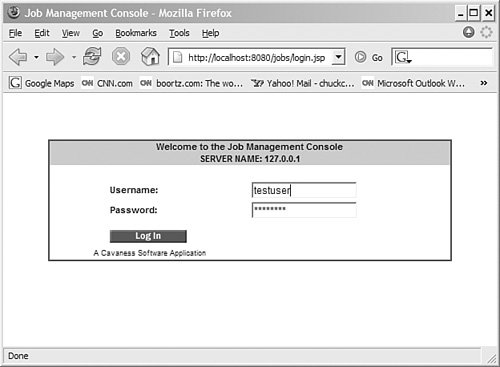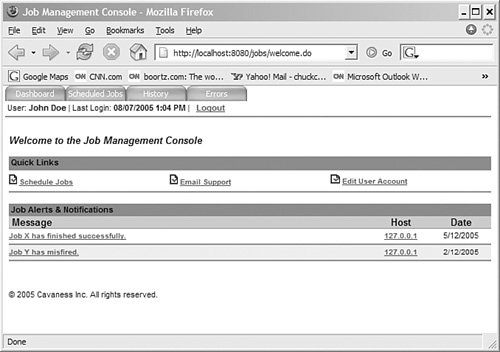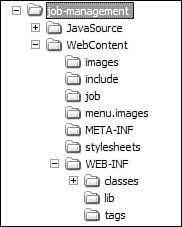Using Quartz with the Struts Framework
The first step is to download Apache Struts and create your Web application directory structure. The Struts framework is available from the Apache Struts site, at http://struts.apache.org. You're welcome to grab the source code and build from that, although the binary download of the latest version should be sufficient.
Because Quartz does not directly depend on the Struts framework, you don't have to worry about the version of Struts that you use. Just grab the latest version that's available. You should realize, however, that the Struts and Quartz frameworks share some third-party dependencies. In fact, the required libraries we listed earlier for Quartz are all required by the Struts framework. Just be careful about mixing up different versions, as the note in the last section warned.
Creating Your Web Application Directory Structure
After you download Struts, you can create your directory structure and install the necessary files. For this example, we're going to create a fictitious Web application called Job Management Console. Because this is just a pretend application, we won't be building it to completion. Instead, we use it to explain several key points of integration with Quartz and leave the rest for you to explore. For now, assume that the boss has given us a task to build a GUI around our Job Scheduling framework (which, of course, would be based on Quartz). Figures 13.1 and 13.2 show the login and main screen of the Job Management Console application.
Figure 13.1. The login screen for our Job Management Console application.

When the user presses the Login button, the application should take the user to the Dashboard screen, which is shown in Figure 13.2.
Figure 13.2 shows the Dashboard of the console, where all users are taken after they log in.
The Dashboard page shown in Figure 13.2 is pretty simple but is good enough for our purposes.
Figure 13.2. The Job Management Console Dashboard is the main screen for users.

Creating the Job Management Console Project Structure
The project structure for the Job Management Console is very standard among Java Web applications, and most Java Web developers will recognize the purpose of most of the directories shown. The tags directory underneath WEB-INF will house the .tld files, used by applications to reference the custom tag libraries. The Struts framework provides several tag libraries that can be used to make JSP development easier; the .tld directories hold the descriptor files for those tags. Figure 13.3 shows the project structure for the application.
Figure 13.3. The project structure for the Job Management Console.

Initializing Quartz Within the Web Application
When Quartz is used from the command line, a Java class is used to create a SchedulerFactory and instantiate a Scheduler instance. Because Quartz will now be running within a Web application, you don't have easy access to the main() method because the application is started by the container, and main() is buried in code, possibly even behind an actual executable. Fortunately, the solution is easy: All you have to do is ensure that when the container first starts the Web application, you have some code that performs the factory-creation logic. That is to say, when the container first loads the web application, you need to create a SchedulerFactory and start the Scheduler.
The QuartzInitializerServlet to the Rescue |
Scheduling in the Enterprise
- What Is Job Scheduling?
- Why job Scheduling Is Important
- Uses for Job Schedulers in the Enterprise
- Uses for Job Schedulers in NonEnterprise
- Job scheduling Versus Workflow
- What about Alternative Solutions?
Getting Started with Quartz
- Getting Started with Quartz
- History of the Quartz Framework
- Downloading and Installing Quartz
- Building Quartz from Source
- Getting Help from the Quartz Community
- Whos Using Quartz?
Hello, Quartz
- Hello, Quartz
- The Hello, World Quartz Project
- Scheduling the Quartz ScanDirectoryJob
- Scheduling a Quartz Job Declaratively
- Packaging the Quartz Application
Scheduling Jobs
- Scheduling Jobs
- The Quartz Scheduler
- The Quartz SchedulerFactory
- Managing the Scheduler
- Managing Jobs
- Volatility, Durability, and Recoverability
- Quick Java Thread Overview
- Thread Usage in Quartz
- Understanding Quartz Triggers
Cron Triggers and More
- Cron Triggers and More
- Quick Lesson in Cron
- Using the Quartz CronTrigger
- The Cron Expression Format
- Using Start and End Dates with CronTrigger
- Using TriggerUtils with the CronTrigger
- Using CronTriggers in the JobInitializationPlugin
- Cron Expressions Cookbook
- Creating a Fire-Now Trigger
JobStores and Persistence
- JobStores and Persistence
- Job Storage
- Job Storage in Quartz
- Using Memory to Store Scheduler Information
- Using Persistent JobStores
- Using the Database for Job Storage
- Creating the Quartz Database Structure
- Using JobStoreTX
- Configuring a DataSource for JobStoreTX
- Running Quartz with JobStoreTX
- Using Memory to Store Scheduler Information
- Using the JobStoreCMT
- Configuring Datasources for JobStoreCMT
- Improving Performance with Persistent JobStores
- Creating New JobStores
Implementing Quartz Listeners
- Implementing Quartz Listeners
- Listeners as Extension Points
- Implementing a Listener
- Listening for Job Events
- Listening for Trigger Events
- Listening for Scheduler Events
- Using the FileScanListener
- Implementing Listeners in the quartz_jobs.xml File
- Thread Use in Listeners
- Uses of the Quartz Listeners
Using Quartz Plug-Ins
- Using Quartz Plug-Ins
- What Is a Plug-In?
- Creating a Quartz Plug-In
- Registering Your Plug-Ins
- Using Multiple Plug-Ins
- Quartz Utility Plug-Ins
Using Quartz Remotely
- Using Quartz Remotely
- Why RMI with Quartz?
- Brief Overview of Java RMI
- Requirements of RMI
- Creating a Quartz RMI Server
- Using the RMI Registry
- Creating the RMI Client
- Testing the RMI Server and Client
Using Quartz with J2EE
- Using Quartz with J2EE
- If I Have J2EE, Why Do I Need Quartz?
- Using the J2EE Containers DataSource
- Using Other J2EE Resources
- The EJB 2.1 Specification: Finally Some Light
Clustering Quartz
- Clustering Quartz
- What Does Clustering Mean to Quartz?
- How Clustering Works in Quartz
- Configuring Quartz to Use Clustering
- Running the Quartz Cluster Nodes
- Quartz Clustering Cookbook
Quartz Cookbook
Quartz and Web Applications
- Quartz and Web Applications
- Using Quartz Within a Web Application
- Integrating Quartz
- Using Quartz with the Struts Framework
- The QuartzInitializerServlet to the Rescue
- Using a ServletContextListener
- Introducing the Quartz Web Application
Using Quartz with Workflow
- Using Quartz with Workflow
- What Is Workflow?
- Job Chaining in Quartz
- Quick Introduction to OSWorkflow
- Integration of Quartz with OSWorkflow
- Creating a Workflow Job
- Conclusion
Appendix A. Quartz Configuration Reference
- Appendix A. Quartz Configuration Reference
- The Main Quartz Properties
- Configuring the Quartz ThreadPool
- Configuring Quartz Listeners
- Configuring a TriggerListener
- Configuring Quartz Plug-Ins
- Configuring Quartz RMI Settings
- Configuring JobStore Settings
- Configuring the JobStoreTX JobStore
- Configuring JobStoreCMT
- Configuring Quartz Datasources
- Configuring a Datasource Using a Custom ConnectionProvider
EAN: 2147483647
Pages: 148
